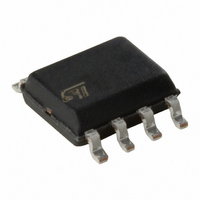M41T56M6E STMicroelectronics, M41T56M6E Datasheet - Page 12

M41T56M6E
Manufacturer Part Number
M41T56M6E
Description
IC SRAM SRL TIMEKPR 512BIT 8SOIC
Manufacturer
STMicroelectronics
Type
Clock/Calendar/NVSRAMr
Specifications of M41T56M6E
Memory Size
56B
Time Format
HH:MM:SS (24 hr)
Date Format
YY-MM-DD-dd
Interface
I²C, 2-Wire Serial
Voltage - Supply
4.5 V ~ 5.5 V
Operating Temperature
-40°C ~ 85°C
Mounting Type
Surface Mount
Package / Case
8-SOIC (3.9mm Width)
Function
Clock/Calendar
Rtc Memory Size
64 Byte
Supply Voltage (max)
5.5 V
Supply Voltage (min)
4.5 V
Maximum Operating Temperature
+ 85 C
Minimum Operating Temperature
- 40 C
Mounting Style
SMD/SMT
Rtc Bus Interface
Serial (2-Wire, I2C)
Nvram Features
RTC, Internal Battery, XTAL
Interface Type
I2C, Serial, 2-Wire
Supply Voltage Range
4.5V To 5.5V
Memory Case Style
SOIC
No. Of Pins
8
Rohs Compliant
Yes
Lead Free Status / RoHS Status
Contains lead / RoHS non-compliant
Other names
497-2818-5
M41T56M6
M41T56M6
Available stocks
Company
Part Number
Manufacturer
Quantity
Price
Part Number:
M41T56M6E
Manufacturer:
ST
Quantity:
20 000
M41T56
Clock Calibration
The M41T56 is driven by a quartz-controlled oscil-
lator with a nominal frequency of 32,768Hz. The
devices are tested not to exceed 35 ppm (parts per
million) oscillator frequency error at 25°C, which
equates to about ±1.53 minutes per month. With
the calibration bits properly set, the accuracy of
each M41T56 improves to better than ±2 ppm at
25°C.
The oscillation rate of any crystal changes with
temperature (see
chips compensate for crystal frequency and tem-
perature shift error with cumbersome “trim” capac-
itors. The M41T56 design, however, employs
periodic counter correction. The calibration circuit
adds or subtracts counts from the oscillator divider
circuit at the divide by 256 stage, as shown in
ure 14., page
blanked (subtracted, negative calibration) or split
(added, positive calibration) depends upon the
value loaded into the five-bit Calibration Byte
found in the Control Register. Adding counts
speeds the clock up, subtracting counts slows the
clock down.
The Calibration Byte occupies the five lower order
bits (D4-D0) in the Control Register (Addr 7). This
byte can be set to represent any value between 0
and 31 in binary form. Bit D5 is the Sign Bit; '1' in-
dicates positive calibration, '0' indicates negative
calibration. Calibration occurs within a 64 minute
cycle. The first 62 minutes in the cycle may, once
per minute, have one second either shortened by
128 or lengthened by 256 oscillator cycles. If a bi-
nary '1' is loaded into the register, only the first 2
minutes in the 64 minutes cycle will be modified; if
a binary 6 is loaded, the first 12 will be affected,
and so on.
12/24
13. The number of times pulses are
Figure 14., page
13). Most clock
Fig-
Therefore, each calibration step has the effect of
adding 512 or subtracting 256 oscillator cycles for
every 125,829,120 actual oscillator cycles, that is
+4.068 or –2.034 ppm of adjustment per calibra-
tion step in the calibration register. Assuming that
the oscillator is in fact running at exactly 32,768Hz,
each of the 31 increments in the Calibration Byte
would represent +10.7 or –5.35 seconds per
month which corresponds to a total range of +5.5
or –2.75 minutes per month.
Two methods are available for ascertaining how
much calibration a given M41T56 may require.
The first involves simply setting the clock, letting it
run for a month and comparing it to a known accu-
rate reference (like WWV broadcasts). While that
may seem crude, it allows the designer to give the
end user the ability to calibrate his clock as his en-
vironment may require, even after the final product
is packaged in a non-user serviceable enclosure.
All the designer has to do is provide a simple utility
that accessed the Calibration Byte.
The second approach is better suited to a manu-
facturing environment, and involves the use of
some test equipment. When the Frequency Test
(FT) Bit, the seventh-most significant bit in the
Control Register, is set to a '1,' and the oscillator is
running at 32,768Hz, the FT/OUT pin of the device
will toggle at 512Hz. Any deviation from 512Hz in-
dicates the degree and direction of oscillator fre-
quency shift at the test temperature.
For example, a reading of 512.01024Hz would in-
dicate a +20ppm oscillator frequency error, requir-
ing a –10(XX001010) to be loaded into the
Calibration Byte for correction.
Note: Setting or changing the Calibration Byte
does not affect the Frequency Test output fre-
quency.













